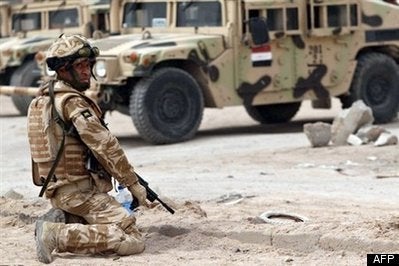
Iraq's increasing environmental problems may destabilize the fragile security gains of the last two years.
At the start of the month, the US vice-president Joe Biden visited Iraq unannounced to consolidate his position as Obama's Mesopotamia point-man. While the visit looked to back up the withdrawal of US troops from urban areas, his attempts to mediate worsening Irbil-Baghdad relations was impeded by a spate of sandstorms in the north of the country.
These are symptoms of a forgotten issue that may destabilize the fragile gains of the past two years. Indeed, while the history of post-invasion Iraq is a narrative largely composed of body counts, electoral milestones, torture scandals and troop numbers; a forgotten story is how the destruction and painfully slow reconstruction of the Iraq state is occurring against the backdrop of a deteriorating natural environment.
Over two years of drought have seriously dented what was already a marginalized and underfunded agriculture sector. Iraq is a largely desert country with an average of only four to just over six-and-a-half inches of rainfall a year; only 13% of its land is arable. Traditionally, agriculture has been the second largest employer behind the oil sector, yet the impact of years of sanctions followed by the 2003 war has compromised the central state's ability to contest the upstream damming of the Tigris and Euphrates rivers by Syria and Turkey.
Despite World Bank opposition, Turkey is proceeding with large scale dam building as part of its "south-eastern Anatolia project", involving the construction of 22 irrigation dams and 19 hydroelectric plants. The subsequent reduction in river flows in Iraq led a recently emboldened Baghdad parliament to pass a resolution last May urging the government to demand a greater share of water resources from neighbors. However, with internal issues still volatile (over 400 civilians died in June) the Iraqi state is in no real position to exert effective pressure on its neighbors.
The consequences of the upstream damming of Iraq's rivers, when compounded with a general trend towards the reduction in rainfall entering the two river basins, is having a severe impact on the Iraqi breadbasket's ability to feed its population. The World Food Program estimates that some 930,000 people are currently food-insecure in Iraq, with a further 6.4 million at risk of becoming food-insecure in the event of the failure of the Public Distribution System (PDS). Resettlement of internally displaced refugees and the potential return of the millions of Iraqis from Jordan and Syria all have the potential to place a further burden on this fragile system. Adam L Silverman, who worked as a social science adviser for the US army human terrain teams in 2008, noted that lack of river discharge leads to "ongoing soil erosion that leads to further desertification and increased heat and dust storms, which has a measurable negative impact on the quality of life of the Iraqis". Reuters reported that the sandstorms that delayed Biden's trip led to several deaths and "hundreds of Iraqis seeking medical help after one of the worst sandstorms in living memory stretched beyond a week, choking throats, clogging eyes and afflicting asthma sufferers in particular".
Desertification and worsening sandstorms are forcing a flight of population to the cities. The consequences of this urbanization place more pressure on the Baghdad's government's limited capacity. Indeed, this month the Red Cross reported noticeable increases in the numbers of Baghdad beggars, all part of the hidden consequences that a battered Iraqi society will take years to recover from.
The recent oil concession conferences signal the acceleration of a process that could have larger ramifications for the Iraqi environment. Poorly maintained and low-quality oil infrastructure and gas flaring are already huge environmental problems, with flaring estimates of 600m cubic feet a day making Iraq the fourth-worst culprit in the world. Iraq is home to an estimated 9% of the world's crude oil supply, a fact that led many of the world's biggest oil companies to attend the July Baghdad contract bidding conference, yet with focus on the levels of nationalization, environmental protection measures may lose out in the rush to increase output.
Behind the violence, the drying rivers, the expanding deserts and the burgeoning cities are forgotten issues that may have crucial roles to play in shaping the direction of a beleaguered Iraq.
